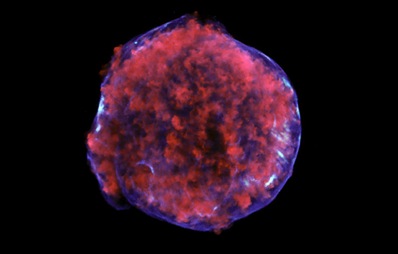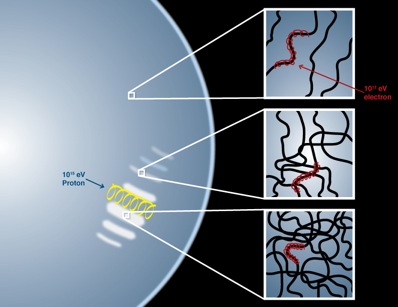



|

|

A stripy supernova explosion
DR EMILY BALDWIN
ASTRONOMY NOW
Posted: 25 March 2011


New observations of the well-studied Tycho supernova remnant by the Chandra X-ray Observatory has revealed a pattern of stripes never before seen in a supernova explosion, which could be responsible for Earth-bound cosmic rays.

High energy X-rays detected from the Tycho supernova remnant, with close-ups of two different regions: region A contains the brightest stripes and region B fainter stripes. The stripes are areas where the magnetic fields are much more tangled and the particle motion is much more turbulent than surrounding areas. Image: X-ray: NASA/CXC/Rutgers/K.Eriksen et al.
The supernova remnant was first observed in 1572 by the Danish astronomer Tycho Brahe, and was the result of an explosion of a white dwarf star located about 13,000 light years from Earth, within the Milky Way. While the 55 light year wide remnant often falls under the scrutiny of astronomical observations, the latest survey has uncovered stripes in its expanding debris.
“We’ve seen lots of intriguing structures in supernova remnants, but we’ve never seen stripes before,” says Kristoffer Eriksen of Rutgers University, who led the study. “This made us think very hard about what’s happening in the blast wave of this powerful explosion.”

A long Chandra X-ray observation reveals stripes in the Tycho remnant, seen in blue (high-energy x-rays) towards the lower right of the image. Image: X-ray: NASA/CXC/Rutgers/K.Eriksen et al.
The observation supports an idea that magnetic fields become twisted in the turbulent environment of the expanding supernova explosion. High-energy charged particles bounce back and forth across the shock wave at the front 'edge' of the supernova, which, according to theory, could lead to the creation of strong and weak patches in the magnetic fields. Therefore, the X-ray stripes observed in Tycho are interpreted as regions of high turbulence, where magnetic fields are more tangled, corresponding to stronger magnetic regions. Electrons trapped in these regions emit X-rays as they spiral around the field lines.
But co-author Jack Hughes says that it was a big surprise to find such a neatly arranged set of stripes: “We were not expecting so much order to appear in so much chaos. It could mean that the theory is incomplete, or that there’s something else we don’t understand.”

A schematic illustration of the process thought to be occurring in Tycho's stripes. The blue, circular region on the left is a schematic representation of the outer shell making up the blast wave of the supernova remnant, with the lighter colored regions being the stripes. The panels show close-ups of tangled magnetic field lines, with spiraling electrons responsible for X-ray emission. The spacing between the stripes corresponds to the radius of the spiraling motion of a proton (shown in yellow), which could be the origin of the most energetic cosmic rays in our Galaxy. Image: NASA/CXC/M.Weiss).
One solution relates to cosmic rays, the source of which has often been pointed towards supernova remnants. However, since cosmic rays are composed of charged particles, their direction of motion is dictated by magnetic fields, and so it is difficult to determine the origin of individual cosmic rays detected on the Earth. Assuming the spacing between the X-ray stripes observed in Tycho represent the radius of the spiraling motion of the highest energy protons, the spacing corresponds to energies equal to the highest energies of cosmic rays thought to be produced in our Galaxy.
“We were excited to discover these stripes because they might allow us to directly track, for the first time, the origin of the most energetic particles produced in our Galaxy,” says Eriksen. “But, we’re not claiming victory yet.”
The results of the study are discussed in The Astrophysical Journal Letters.
|

|

|

|
|



